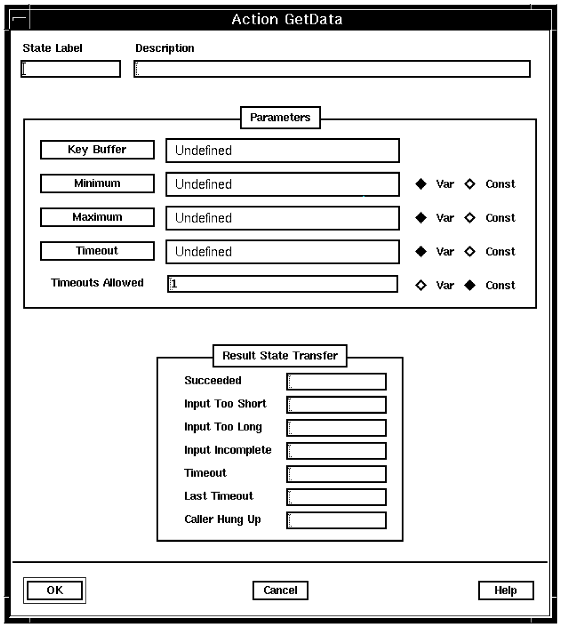Purpose
Use GetData to retrieve information provided by a caller when the caller must press more than one key on the telephone keypad to transmit the information.

Description
GetData retrieves the result of pressing a series of keys in a single step.
The last key pressed must be the key identified by the Enter Key system parameter in the Application Server Interface group. By default, this is the pound (#) key.
GetData receives the information and stores it in a temporary buffer. The contents of the buffer are then assigned to the Key Buffer parameter variable for use by other states. If GetData fails for some reason (for example, if the caller does not provide complete input, the GetData result is Input Too Short or Input Incomplete), GetData still copies the contents of the buffer to the Key Buffer parameter variable and clears the temporary buffer.
GetData causes an automatic fade out of any background music. You can override this by using the System : Music : Automatic fade before actions system variable (SV226).
Parameters
The parameters for GetData identify the variable to which the information received from the caller is assigned. They also define characteristics of the information and operating rules for the action.
- Key Buffer. Specifies the variable to which the contents of the buffer are assigned.
- Minimum. If the variable specified for Key Buffer is defined as a character string, the value of Minimum defines the minimum number of characters that a caller must key in. If the variable is defined as numeric, the value of Minimum defines the smallest acceptable number that a caller can key in. The minimum value for this variable is 0.
- Maximum. If the variable specified for Key Buffer is defined
as a character string, the value of Maximum defines the largest number of
characters that a caller can key in. If the variable is defined as numeric,
the value of Maximum defines the largest acceptable number that a caller can
key in. The maximum value allowed is 99 999.
If the value defined for Minimum is the same as the value defined for Maximum, the caller will not have to press the pound key to indicate that the information is complete. Once the action receives the number of characters (or the number) defined by the values of Minimum and Maximum, it moves to the next state. When this happens, the next prompt is force-played for the first 0.8 seconds to discard any extra keys the caller has pressed.
- Timeout. Specifies how many seconds the application waits for a caller to press each key, when entering information. The timeout period is reset for each key. For example, with a Timeout of 8, if the caller presses the first key before eight seconds has elapsed, there is then another eight seconds for the caller to press the next key.
- Timeouts Allowed. Specifies the maximum number of timeouts allowed
for this GetData action. When the Timeouts Allowed value is reached, the application
branches to the state identified for the Last Timeout result.
The timeout counter retains its value until a new Get action (GetData, GetFindData, GetFindName, GetKey, GetPassword, or GetText) is encountered.
The timeout counter applies to the current line of the state table. When the Last Timeout result has been returned, the counter is reset. Also, note that the debugger treats each statement, or line, as a separate state table, so two consecutive Get actions appear as one action to Blueworx Voice Response. Last Timeout could therefore be returned when Timeout is expected. This is a limitation of the debugger.
The Last Timeout result is returned for any GET action if fax detection is turned on, and is detected. Check SV180 to see if fax was detected.
Possible results
GetData can have one of the following results:
- Succeeded
- The caller entered information that matched all of the parameters. The information has been assigned to the specified variable.
- Input Too Short
- The number of characters (or the number) the caller entered was less than the Minimum parameter.
- Input Too Long
- The number of characters (or the number) the caller entered exceeded the Maximum parameter.
- Input Incomplete
- The caller did not press the pound key.
- Timeout
- The time defined by Timeout has elapsed and the caller has not entered the information.
- Last Timeout
- The application has repeated this GetData action for the number of times defined by the value of Timeouts Allowed.
- Caller Hung Up
- The caller has hung up.
ASCII syntax
When using an ASCII editor, code this action with these parameters in the following order:
- Key Buffer input, local or system variable
- Minimum
- Maximum
- Timeout
- Timeouts allowed
For example:
label: "Check Edges" GetData(loc2_n, 12, 25, 10, 5) edge EDGE_GETD_LEN_OK: len_ok edge EDGE_GETD_TOO_SHORT: too_short edge EDGE_GETD_TOO_LONG: too_long edge EDGE_GETD_INCOMPLETE: incomplete edge EDGE_TIMEOUT: timeout edge EDGE_LAST_TIMEOUT: last_timeout edge EDGE_HUP: hup ;
The parameters and edges are described above under "Parameters" and "Possible results". For more information, see Testing a state table using the debugger.